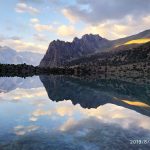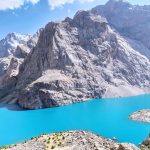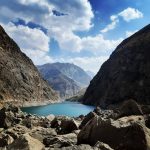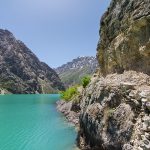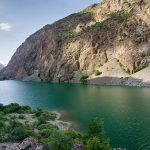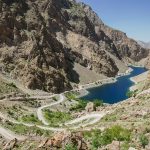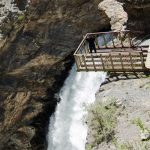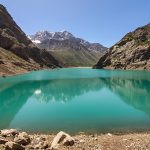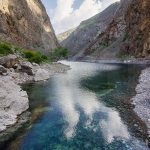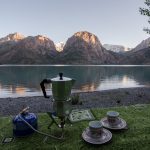The Haft Kul (translated to ‘the Seven Lakes’ in the Tajik language) is a series of seven glorious alpine lakes of all sorts of shapes, sizes, and colors nestled within the rocky Fann Mountains of northwestern Tajikistan. Often overshadowed by more famous hiking trails in the Pamir Mountains, trekking in Fann Mountains is quieter yet just as rewarding.
Having served as a popular adventure destination since the Soviet era, the Seven Lakes of Shing valley, also known as the Marquzor Lakes, are enshrouded in fascinating local folklore. According to local legend, a smith lived in the mountains with his seven attractive daughters. When the governor saw one of the daughters, he fell in love with her straight away and asked her father for her hand in marriage.
However, as she was the youngest daughter, she did not want to get married to the much older man, and said that she would only do so if he built her a palace made completely of gold. Believing this to be impossible, the girl was shocked when he managed to achieve it in just 40 days. When she realized she would have to go through with the marriage, she climbed to the roof of the palace and threw herself off, still dressed in her wedding dress. This is where Mizhgon Lake stands today, and it said that the remaining six of the Seven Lakes were formed by the tears of the girl’s heartbroken sisters.
The reality behind the Seven Lakes’ conception is quite different, however, and nowhere near as interesting. They were actually created through years and years of earthquakes and mudslides. The resulting debris built up in the Shing River, eventually blocking off the flow of the river and forming what we now know to be the Haft Kul in Fann Mountains (the Seven Lakes).
Located near the Uzbek boundary, the Seven Lakes are one of Tajikistan’s most accessible trekking destinations. If you are interested in trekking and hiking in Tajikistan, the Seven Lakes region is a popular choice. Six out of the seven lakes are easily reached with a car or motorbike, while the seventh requires several hours’ worth of hiking. The journey is a moderately easy trek along a dirt track and the route is breathtakingly beautiful, characterized by color-changing lakes, hairpin bends, and dramatic mountain slopes covered in grazing farm animals.
Along the way, you will get to admire one spectacular lake after another – each slightly unique from the last. The lakes change in color from black to green to brilliant blue. The first, named Mizhgon (which means Eyelash), is a curvaceous, vivid turquoise lake that gets its color from the presence of minerals in the water. The second lake, Soya (which means Shade), is named so because it is nearly always in shade. The third lake is known as Hushyor (meaning Vigilance) which is a reference to a large number of poisonous snakes found nearby.
Nofin (the fourth lake), is the longest lake, Khurdak (the fifth lake) which means ‘Little One’ is the smallest, and Marguzor (the sixth lake) is the largest and easily the most picturesque. Lastly, Hazorchazma (the seventh lake), which means a Thousand Springs, boasts an abundance of natural springs and creeks and was once a famous landmark along the Great Silk Road. Today, tourists are drawn to the region by the allure of hiking and trekking past the lakes and camping under the stars or in a traditional homestay.
While many prefer to drive past six of the lakes and hike only from the sixth to the seventh lake, those looking for a challenge can trek from the first to the last over the course of several days. Trekking in Fanns here is easy and you do not need any special hiking gear for trekking around the Seven Lakes. However, as the Fann Mountains are more rural, the dress code tends to be more conservative. So, be sure to wear respectable clothing with long sleeves and trousers.
The Marquzor Lakes are easily accessible from both Tajikistan and Uzbekistan. Panjakent in Tajikistan is the nearest big town to the Seven Lakes and can be visited easily on a day trip from the city. The Seven Lakes also be reached from Dushanbe and Khujand as well as Samarkand, Uzbekistan, but you will need to allow yourself a bit more time to experience it all. Take note that you will need to carry your passport with you when you visit the Seven Lakes as you will pass through border control near the Shing village.
If you are trying to decide when the best time is to visit the Fann Mountains, the middle of June to the end of August are the warmest months of the year. These months, due to their excellent conditions for hiking, are also usually the busiest. If you are looking to escape the crowds in the Fann Mountains, October is best. The winter months, between November and April, are a tricky time to visit the Fann Mountains as the roads are covered in heavy snow and some of the routes may not be manageable. Keep this in mind when you plan your Tajikistan trekking holiday.
Seven Lakes of Shing valley is one of the most popular Tajikistan attractions, along with Iskanderkul Lake located near Sarytag village. If you are looking for a real adventure, Trekking in Fann Mountains, Tajikistan can be combined with a host of other activities with Paramount Journey’s northern Tajikistan tours. Get in touch for more information!






